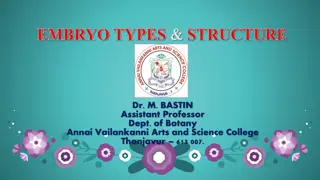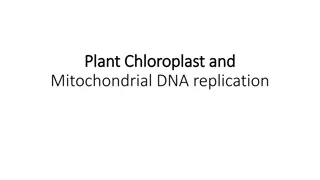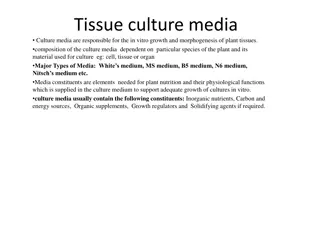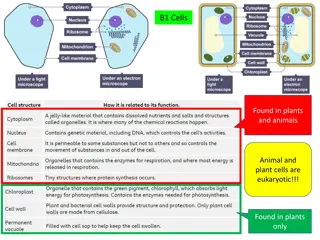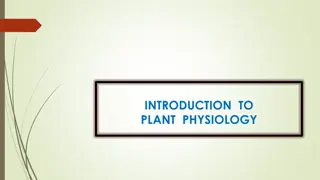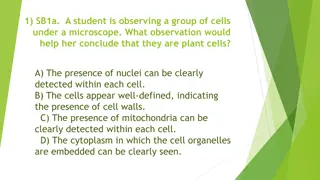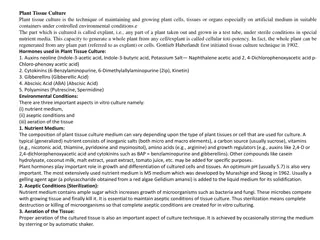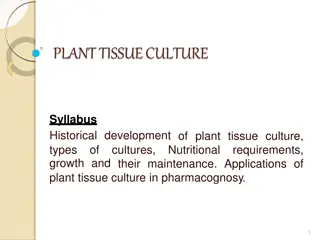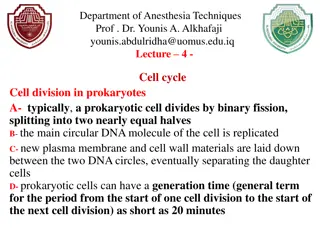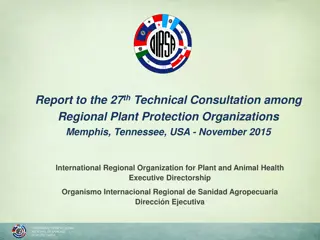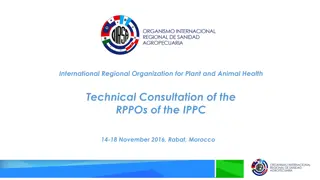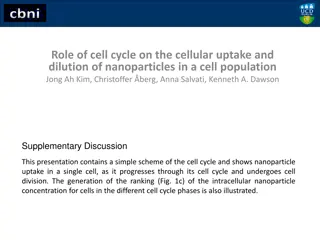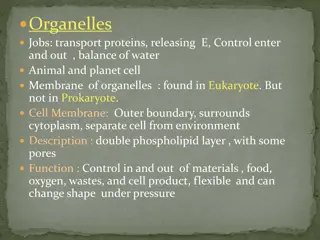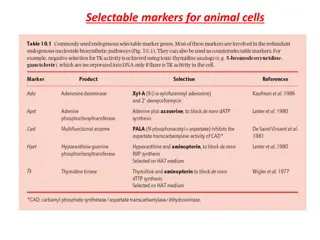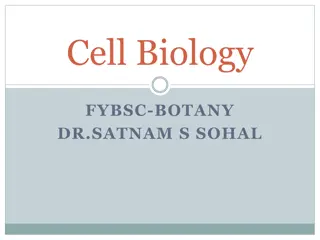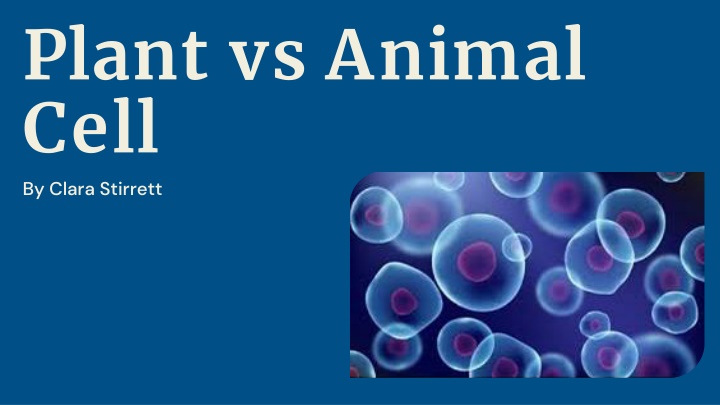
Plant vs. Animal Cells: A Detailed Comparison for Education and Awareness
Explore the differences between plant and animal cells, crucial for medical, agricultural, and environmental sciences. Understand the similarities, functions, and adaptations with visual aids to enhance education and awareness. Discover the unique features of both eukaryotic cells through detailed observations under an electron microscope.
Download Presentation

Please find below an Image/Link to download the presentation.
The content on the website is provided AS IS for your information and personal use only. It may not be sold, licensed, or shared on other websites without obtaining consent from the author. If you encounter any issues during the download, it is possible that the publisher has removed the file from their server.
You are allowed to download the files provided on this website for personal or commercial use, subject to the condition that they are used lawfully. All files are the property of their respective owners.
The content on the website is provided AS IS for your information and personal use only. It may not be sold, licensed, or shared on other websites without obtaining consent from the author.
E N D
Presentation Transcript
Plant vs Animal Cell By Clara Stirrett
Defining the Problem 1. -Problem -Plant Cell -Animal Cell Making Observations - Similarities and differences - functions and adaptations - Visual Aids 2. Drawing a Conclusion 3. - Measures of Effectiveness - Conclusion - The End 2
Problem My problem is people are not generally educated on this subject which can lead to limited career options and knowing the difference between plant and animal cells may seem not a priority however knowing the difference between plant and animal cells is crucial for several reasons such as: Medical and biological reasons Agriculture and food production environmental science Education and awareness 3
Plant Cell Science Presentation A plant cell, the basic unit of all plants. Plant cells, like animal cells, are eukaryotic, meaning they have a membrane-bound nucleus and organelles. The plant cell is and comparatively larger than the animal cell even though plants and animal cells are eukaryotic and share a few cell organelles plant cells are quite distinct when compared to animal cells as they perform different functions some of these differences can be clearly understood when the cells are examined under an electron microscope 4
Animal Cell Animal cells give bodies structure, absorb nutrients to convert to energy, and help animals move. They also contain all the hereditary material of an organism and can make copies of themselves. These cells are further described as eukaryotic cells. Eukaryotic cells have a well- defined nucleus surrounded by a nuclear membrane. The nucleus is where the cell s DNA is located. Animals,plants, and fungi are made up of these types of cells.
Making Observation s - Similarities and differences - functions and adaptations - Visual Aids 6
Similarities and Differences Both animal and plant cells are eukaryotic cells and have several similarities. The similarities include common organelles like cell membrane, cell nucleus, mitochondria, endoplasmic reticulum, ribosomes and golgi apparatus. As plant animal cells are interconnected they have many similarities and things in common such as mitochondria,Ribosomes, plasma membrane, endoplasmic reticulum ,nucleus and Golgi apparatus Despite their fundamental similarities, there are some striking differences between animal and plant cells. Animal cells have centrosomes, and lysosomes, whereas plant cells do not. Plant cells have a cell wall, chloroplasts, and plastids used for storage, and a large central vacuole, whereas animal cells do not. 7
Functions and adaptations Plant Specific functions include Plant Specific functions include - Photosynthesis: Plant cells use chloroplasts to turn sunlight into food - Structure:the cell wall give plants a structured Rigid shape -Water Storage:the large vacuole stores water and keeps the plant cell firm Animal Specific functions include Animal Specific functions include - Movement: some animal cells have cilia or flagella to help the move - Breaking things down: lysosomes are more active in animal cells to digest substances
Functions and adaptations Plant Plant- -Specific Adaptations Specific Adaptations: Chloroplasts: contain chlorophyll to capture sunlight Cell wall: made of strong cellulose to keep this plant cell wall strong and protect the cell Flexible Vacuole: stores water and helps the plant adapt to its environment Animal Animal- -Specific Adaptations Specific Adaptations: Specialized Shapes: For example, red blood cells are small and round to carry oxygen easily. Flexibility: No cell wall means animal cells can change shape. Nerve Cells: Long and thin to send signals quickly over long distances.
Visual Aids Of Plant and Animal Cells Plant Cell Animal Cells Animal cells come in many different shapes and sizes. The shapes of cells have evolved to help them carry out their specific function in the body, so looking at a cell's shape can give clues about what it does. Observations -Green (due to chlorophyll) - translucent -wire like rods that twist in zig-zags -slight grainy texture - rods are 3d -Pinkish with red spots in the center -closely packed together cells -shiny texture -red spots seem to be 3d
Drawing a Conclusion - Measures of Effectiveness - Conclusion - The End
Cell Reproduction: Plant Plant Plant pros Animal pros Flexibility - Plant cells reproduce both sexually (via seeds) and asexually (via cloning, grafting, etc.), which gives them an edge in adapting to different environments or survival strategies. Genetic Diversity - Through reproduction and meiosis, animal cells contribute to genetic variety, which is crucial for evolution and adaptation. Plant Animal Disposal of Waste/Toxins in the Cell: Animal Animal Plant pros Animal pros Plant cells focus on safety and sustainability Their central vacuole isolates waste and toxins, acting like a secure storage locker. While this process is slower, it works well for plants, as they don t need to be as dynamic as animals. They also have the clever advantage of permanently storing waste in parts (like leaves) that they can later shed. Animal cells are better for speed and activity With their lysosomes breaking down waste quickly and the support of a circulatory system for removing toxins, animal cells are like a "fast cleanup crew." This efficiency is crucial for high- energy organisms that need to stay active and responsive. Plant Animal
Structure: Plant Plant Plant pros Animal pros Cell Walls Plant cells have a strong outer layer called the cell wall that helps keep their shape. Cytoskeleton Animal cells have a skeleton-like structure inside called the cytoskeleton that helps maintain their shape and move things around inside the cell. Connections Plant cells connect with each other through channels called plasmodesmata, allowing communication between cells and creating bonds to support the cell. Cell Junctions They have special junctions that hold cells together and help them communicate with each other. Fixed Shape Because of the cell wall and big vacuole, plant cells usually keep a rectangular or hexagon shape. Flexible Membrane Their cell membrane allows them to take in nutrients and remove waste efficiently. Plant Static Nature: Since plants are stationary, their cells have adapted to withstand various environmental pressures (wind, gravity, etc.). The rigid structure supports the plant in standing upright and enduring external forces. Extracellular Matrix (ECM) The ECM is a network outside the cells that provides support and helps cells stick together, adding to the overall stability of tissues. Animal
Aiding Cell with Functions/Adaptations: Animal Animal Plant pros Animal pros Plant Their rigid structure, energy independence through photosynthesis, and ability to store water and nutrients make them perfectly suited for stability and long-term survival in a stationary environment. They re masters of efficiency and endurance. Their flexibility, high energy output, and specialization make them fantastic for dynamic environments and rapid responses. They enable advanced systems like muscles and nerves, which give animals the ability to move, sense, and interact with the world. Animal Overall Score Plant I got to the overall score by tallying up the scores from the measures of effectiveness 2 Animal 2
Conclusion In conclusion we cannot deem one better Than The other the other since they are both perfectly suited to their different environments. This research project could have different results due to the limited number of variables (measures of effectiveness) and the limited time slot.
The End 16



